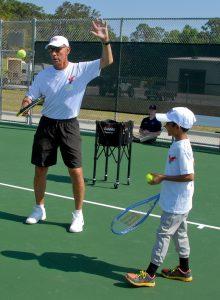We may earn money or products from the companies mentioned in this post.
Introduction

Tennis is a sport that requires precision, agility, and skill Every aspect of the game, from technique to equipment, can have a significant impact on performance One often overlooked element is the stringing of a tennis racket Properly stringing a racket can make all the difference in how it performs on the court
The Importance of Stringing
When it comes to tennis racket performance, stringing plays a crucial role The strings are responsible for transferring power from your swing to the ball and controlling its trajectory The way the strings are strung affects how much power you can generate and how much control you have over your shots
Imagine trying to hit powerful serves or precise volleys with loose or worn-out strings The lack of tension and consistency would greatly hinder your ability to make clean contact with the ball, resulting in less power and accuracy
Proper String Tension:
String tension is another essential factor in racket performance The tension determines the responsiveness of the strings and impacts several aspects of play, including power, control, spin potential, and feel
If the strings are strung too tightly, they may feel stiff and unresponsive, making it difficult to generate power or apply spin effectively On the other hand, if the strings are strung too loosely, you may experience loss of control as they become more prone to shifting upon impact with the ball
Common Reasons for Restringing
-
Loss of Tension:
-
Broken Strings or Fraying:
Over time and with regular use, tennis racket strings lose their tension This loss occurs gradually but can result in noticeable changes in playability As tension decreases, so does power generation and control To maintain optimal performance, it is necessary to restring the racket periodically
Another common reason for needing to restring a tennis racket is broken strings or fraying The intense impact of the ball on the strings, combined with natural wear and tear, can lead to string breakage or damage When this happens, it is essential to replace the affected strings promptly to ensure consistent playability
In conclusion, stringing a tennis racket correctly and maintaining proper tension are vital for optimal performance on the court Whether you’re an amateur player or a seasoned pro, taking care of your racket by restringing it when needed will help you achieve better power, control, and overall proficiency in your game
Necessary Tools and Materials for Stringing a Tennis Racket

When it comes to stringing your tennis racket, having the right tools is essential Here is a list of the necessary tools and materials that you will need:
-
Racket Stringing Machine:
The first tool on the list is a racket stringing machine This machine allows you to efficiently and accurately string your racket with ease There are two main types of machines available: manual and electronic machines Manual machines require you to manually adjust the tension, while electronic machines have automatic tension control-
Manual vs Electronic Machines:
Manual machines offer more control over the tension, but they require more effort and skill to use effectively On the other hand, electronic machines are easier to operate but may not provide as precise tension adjustments -
Different Types of Machines:
Within each category, there are different types of stringing machines available These include drop weight, crank, and constant pull machines Each type has its own unique features and benefits
-
-
String Clamps:
String clamps are used to hold the strings in place while you string your racket They ensure that the tension remains consistent throughout the process -
Awl:
An awl is a pointed tool that helps you weave the strings through the grommets on your racket frame -
Pliers or Cutters:
Pliers or cutters are necessary for trimming excess string length after you have finished stringing your racket
Choosing the Right Type of Strings for Your Racket and Playing Style

Now that you have the necessary tools, it’s time to choose the right type of strings for your racket and playing style Here are a few factors to consider:
-
Natural Gut vs Synthetic Strings:
The two main types of strings available are natural gut and synthetic strings Natural gut strings offer excellent playability and feel but tend to be more expensive and less durable On the other hand, synthetic strings are more affordable and durable, but they may not provide the same level of comfort and touch-
Advantages and Disadvantages:
Natural gut strings provide better tension maintenance, control, and power However, they are susceptible to moisture and lose tension faster than synthetic strings Synthetic strings offer improved durability, spin potential, and affordability -
Ideal Playing Conditions:
Natural gut strings perform best in moderate weather conditions as they can be affected by high humidity or extreme temperatures Synthetic strings, on the other hand, are more versatile and can handle a wider range of playing conditions
-
-
String Gauge (Thickness):
Another important consideration is the string gauge or thickness Thicker gauge strings tend to be more durable but may sacrifice some playability and spin potential Thinner gauge strings offer better feel, playability, and spin potential but may break more easily
By understanding these factors and choosing the right tools and materials for stringing your tennis racket, you can ensure optimal performance on the court
How to String Your Tennis Racket

Stringing a tennis racket may seem like a daunting task, but with the right guidance and a little practice, you can do it yourself In this article, we will take you through the step-by-step process of stringing your tennis racket, from preparing the racket to adding those finishing touches So grab your racket and let’s get started!
Preparing the Racket for Stringing
The first step in stringing your tennis racket is to remove the old strings This can be done using a string cutter or by carefully unraveling them Once the strings are removed, it’s time to clean the grommets – those small plastic pieces that hold the strings in place Use a toothbrush or a soft cloth to remove any dirt or debris from the grommets, ensuring smooth movement for your new strings
Setting up Your Stringing Machine
Before you begin stringing, make sure you have set up your stringing machine correctly Start by selecting the appropriate mounting system for your racket frame There are three common options: two-point mounting system, four-point mounting system, and six-point mounting system Choose the one that suits your needs and follow the manufacturer’s instructions for installation
Next, adjust the tension settings on your stringing machine according to your preference or as recommended by your racket manufacturer Tension is an important factor that affects both power and control in your shots, so take some time to find what works best for you
Main Strings (Longitudinal Strings)
Now it’s time to start threading the main strings through the grommet holes near the throat of your racket Begin with one end of the string and weave it through the grommets, alternating sides as you go along It’s crucial to maintain equal tension on both sides as you string Use a starting clamp to hold the first few strings in place and continue until all the main strings are completed
Cross Strings (Horizontal Strings)
With the main strings in place, it’s time to add the cross strings Start at the top of the head section and weave the string over and under each main string, creating a crisscross pattern This process requires precision and attention to detail, ensuring that each cross string is properly aligned with its corresponding main string Once all the cross strings are woven, knot them off at appropriate grommets using proper techniques
Finishing Touches
Before you wrap up your stringing journey, there are a couple of important steps to complete First, check the overall string tension using a tension meter or gauge to ensure consistency across all strings If any adjustments are necessary, make them carefully according to your desired tension level
Finally, take some time to inspect your racket for any loose knots or unevenly tightened strings Make any necessary adjustments or corrections before giving your racket a final once-over
There you have it – a newly strung tennis racket ready for action! Remember that practice makes perfect when it comes to stringing rackets, so don’t be discouraged if it takes a few tries to get everything just right With time and patience, you’ll become an expert at maintaining your own tennis gear
Tips for maintaining your tennis racket’s strings

When it comes to keeping your tennis racket in top condition, paying attention to the strings is crucial Here are a few tips to help you maintain your racket’s strings:
Regularly checking for fraying or loose strings
Before every match or practice session, take a moment to inspect your racket’s strings Look out for any signs of fraying or loose strings If you notice any damage, it’s important to address it promptly to prevent further deterioration
Storing the racket in a temperature-controlled environment
The environment in which you store your tennis racket plays a significant role in preserving its string tension and overall performance It’s best to keep your racket in a cool, dry place away from extreme temperatures and humidity This will help maintain the integrity of the strings and prevent them from losing tension prematurely
Common mistakes to avoid while stringing a tennis racket

Stringing a tennis racket requires precision and attention to detail Here are two common mistakes that you should avoid:
Over-tightening or under-tightening the strings
Finding the right tension for your racket’s strings is essential for optimal playability Over-tightening can put excessive strain on the frame and lead to premature breakage, while under-tightening can result in lackluster performance Make sure to follow manufacturer guidelines or consult with a professional stringer for guidance
Skipping or misaligning grommet holes
Grommet holes are designed to protect the strings from friction against the frame When stringing your racket, be careful not to skip any grommet holes or misalign them as this can cause unnecessary stress on the strings Take your time and ensure each string is properly threaded through its corresponding grommet hole
How often should you restring your tennis racket?

The frequency of restringing your tennis racket depends on various factors:
Factors that determine the frequency of restringing
-
The level of play (beginner, intermediate, advanced):
As a general rule, more advanced players tend to generate greater power and spin, which puts additional strain on the strings Therefore, advanced players may need to restring their rackets more frequently compared to beginners -
Frequency of playing matches/practice sessions:
The more frequently you play, the faster your strings will wear out If you’re a regular player who hits the court multiple times a week, you’ll likely need to restring your racket more often than someone who plays less frequently
By considering these factors and monitoring the condition of your strings regularly, you can determine when it’s time for a restring Remember that well-maintained strings contribute to better performance and enjoyment on the tennis court!
Useful Links

How to string a tennis racket
How to String a Tennis Racket | Step by Step (with Pictures)
Ultimate Guide to Tennis Racquet Stringing
Strings (tennis)
How to String a Tennis Racket
How to Choose a Tennis String
SPAGHETTI STRUNG RACQUETS
How to String a Tennis Racket Without a Machine: DIY Guide
How to Choose Tennis Strings | 5-Step Guide
Understanding Tennis String Construction And Why It Matters
How to String a Tennis Racquet
How to Choose Tennis Strings – Buying Guide by …
An Expert Guide to the Best Tennis Racquet Strings
Custom Stringing Service – Tennis-Point
Tennis Racquet String Patterns Explained
A Tennis Racket Strung With Guitar Strings: The Ultimate …
Sergetti | Tennis stringing method that optimizes the …
Tennis Racquet Stringing + Home Pickup






